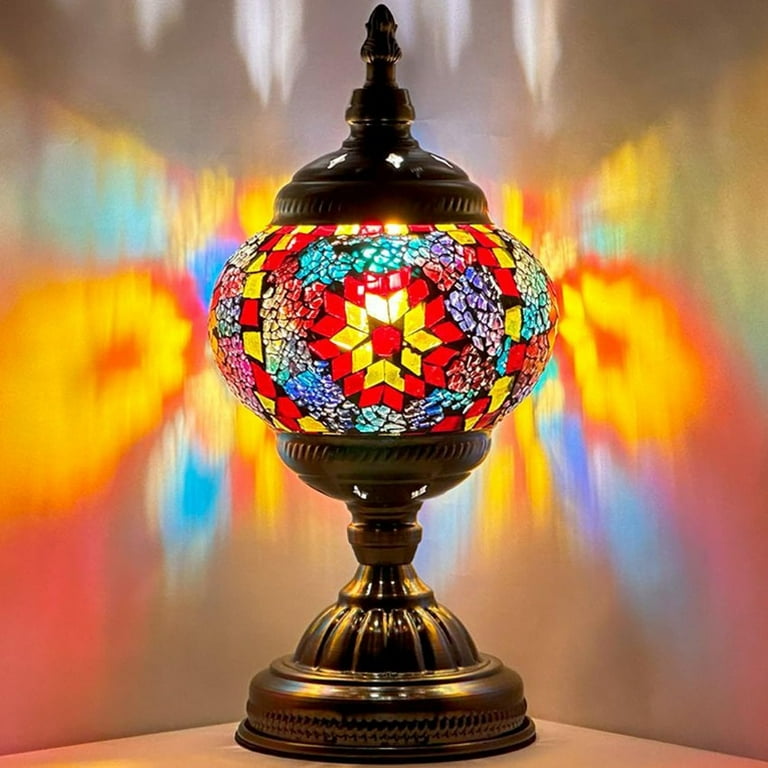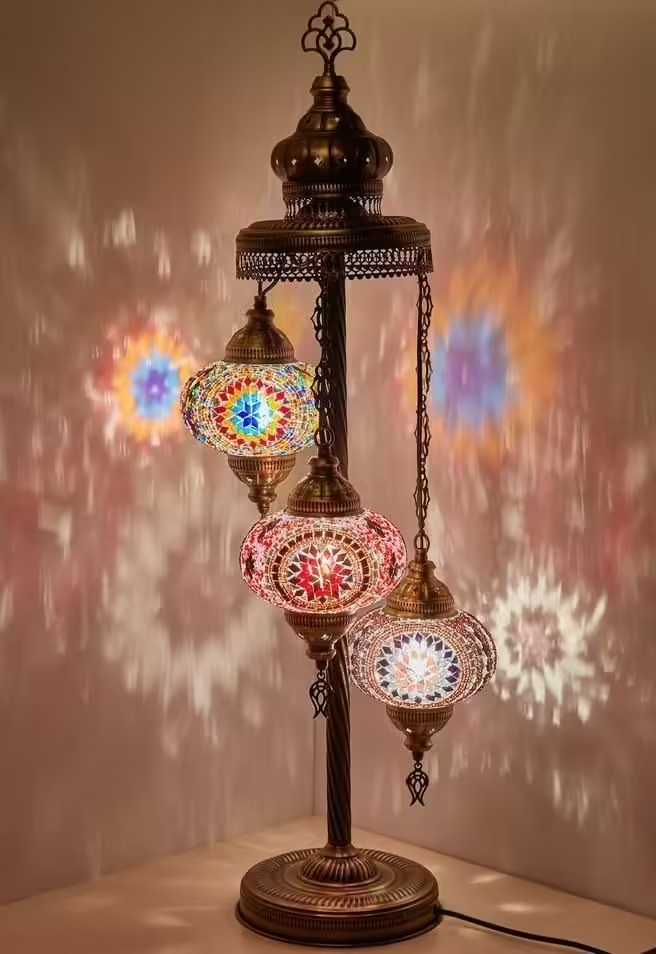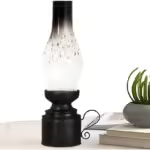Turkish lamps are traditional light fixtures known for their vibrant colors and intricate mosaic designs. They add elegance and cultural flair to any space.
Turkish lamps, crafted with meticulous care, offer a unique blend of artistry and functionality. These lamps are made using colorful glass pieces and metalwork, creating stunning patterns that reflect Ottoman heritage. Their warm, ambient light transforms living spaces, making them cozy and inviting.
Available in various styles, including hanging lamps, table lamps, and wall sconces, they cater to diverse aesthetic preferences. Perfect for home decor, Turkish lamps also make thoughtful gifts. Each lamp is a testament to skilled craftsmanship, ensuring both beauty and durability. Enhance your home with the timeless charm of Turkish lamps.

Credit: www.ebay.com
History Of Turkish Lamps
Turkish lamps are beautiful and unique. These lamps have a rich history. They come from a place with a vibrant culture. Their beauty and craftsmanship make them special. People from all over the world admire them. Let’s explore the history of Turkish lamps and how they evolved.
Cultural Origins
Turkish lamps come from Turkey. Turkey has a rich cultural heritage. These lamps are a part of that heritage. They combine art and function. People use them to light up their homes. They also use them as decorations.
The design of these lamps is unique. They often have colorful glass pieces. These pieces are put together by hand. This technique is called mosaic. Mosaic art is very old. It dates back to ancient times. Turkish lamps use this old art form.
Here are some key points about the cultural origins of Turkish lamps:
- Handmade with care and precision.
- Colorful glass pieces create beautiful patterns.
- Mosaic art is an ancient technique.
- Part of Turkish heritage for many years.
In Turkish culture, lamps are more than just light sources. They symbolize warmth and hospitality. They are often given as gifts. A Turkish lamp can be a beautiful friendship lamp. It shows care and friendship.
Evolution Over Time
Turkish lamps have changed over the years. Their design has evolved. New materials and techniques are now used. But, they still keep their traditional charm.
In the past, these lamps were made using simple tools. Craftsmen used hand tools to shape the glass. Today, machines help in the process. This makes the work faster. But, the skill of the craftsman is still important.
The design of Turkish lamps has also changed. Modern designs are now available. You can find a modern floor lamp with Turkish designs. These lamps fit well in modern homes. They blend tradition with modernity.
Here is a table showing the evolution of Turkish lamps:
| Period | Materials | Techniques |
|---|---|---|
| Ancient Times | Clay, simple glass | Hand tools |
| Medieval Times | Colored glass | Mosaic art |
| Modern Times | Various glass types | Machine and hand tools |
Today, Turkish lamps are popular worldwide. They come in various styles. Some look like vintage lamps. Others are designed for special occasions, like a Christmas story lamp. You can even find rain lamps and stained glass lamps with Turkish designs.

Credit: www.amazon.com
Materials Used
Turkish lamps are famous for their rich colors and intricate designs. They bring a touch of elegance and warmth to any space. The materials used in these lamps are crucial for their beauty and durability. This article explores the different types of glass and metal frameworks used in Turkish lamps.
Glass Types
Turkish lamps come in various glass types. Each type has its unique charm. The glass used in these lamps is often hand-cut and hand-painted. This process ensures each lamp is unique. Some common glass types include:
- Stained Glass: Stained glass is popular for its vibrant colors. It creates a beautiful glow when the lamp is lit. This type is often seen in glass lamps and green lamps.
- Mosaic Glass: Mosaic glass involves small pieces of glass arranged in patterns. These patterns can be geometric or floral. Mosaic glass adds a touch of artistry to the lamp.
- Blown Glass: Blown glass is made by shaping molten glass. This type is often used in more delicate lamp designs. Blown glass allows for smooth curves and elegant shapes.
Each glass type contributes to the lamp’s overall appearance. They also affect the lamp lumen myriad and how the light is dispersed. A lamp lumen myriad resonance beacon can make the light softer or more focused. This variety allows you to choose the perfect lamp for your space.
Metal Frameworks
The metal framework of a Turkish lamp is just as important as the glass. It provides structure and support. Common metals used include brass, copper, and iron. Each metal has its benefits:
- Brass: Brass is durable and resistant to corrosion. It has a warm, golden color. This makes it perfect for lamp finials.
- Copper: Copper is known for its reddish-brown hue. It develops a beautiful patina over time. This adds to the lamp’s charm and character.
- Iron: Iron is sturdy and strong. It is often used for larger lamps. Iron frameworks can be intricately designed for added beauty.
The metal framework also affects the lamp’s overall look. A well-crafted framework enhances the glass’s beauty. It also ensures the lamp is stable and long-lasting. Whether you choose a gas lamp or a lamp for a trailer, the framework plays a crucial role.
The combination of glass and metal makes Turkish lamps stand out. These materials ensure the lamp is not only beautiful but also functional. They create a unique and enchanting light source for any room.
Crafting Techniques
Turkish lamps are renowned for their beautiful designs and intricate crafting techniques. These lamps are not only a source of light but also a piece of art. They add a touch of elegance and culture to any space. The crafting techniques behind these lamps are what make them so special and unique.
Hand-blown Glass
Hand-blown glass is a traditional technique used in making Turkish lamps. This method involves heating glass to a high temperature until it becomes molten. The artisan then blows air into the glass, shaping it into various forms. This process requires great skill and precision.
Benefits of Hand-Blown Glass:
- Each piece is unique.
- High-quality and durable.
- Beautiful and intricate designs.
The hand-blown glass technique allows for the creation of various shapes and sizes. Artisans can experiment with different colors and patterns. This leads to a wide variety of stunning lamp designs.
Steps in Hand-Blown Glass Crafting:
| Step | Description |
|---|---|
| 1 | Heating the glass to a molten state |
| 2 | Blowing air into the glass to shape it |
| 3 | Adding colors and patterns |
| 4 | Cooling and solidifying the glass |
Mosaic Art
Mosaic art is another popular technique used in Turkish lamps. This involves arranging small pieces of colored glass or tiles to form a pattern. The pieces are carefully selected and placed by hand. This results in a beautiful and intricate design.
Features of Mosaic Art:
- Rich in color and detail.
- Handcrafted with precision.
- Each lamp tells a unique story.
Mosaic art requires patience and an eye for detail. Artisans spend hours arranging the tiny pieces to create the perfect pattern. The end result is a stunning piece of art that can light up any room.
Steps in Mosaic Art Crafting:
| Step | Description |
|---|---|
| 1 | Choosing the colors and materials |
| 2 | Cutting the glass or tiles into small pieces |
| 3 | Arranging the pieces into a pattern |
| 4 | Securing the pieces in place |
Turkish lamps made with mosaic art are not just functional but also decorative. They add a touch of elegance and culture to any space. These lamps are a testament to the skill and creativity of Turkish artisans.

Credit: www.walmart.com
Design Styles
Turkish lamps are known for their intricate designs and vibrant colors. They add a touch of elegance to any space. These lamps come in various design styles, each offering a unique aesthetic. Traditional patterns and modern interpretations are two prominent styles. Both have their own charm and appeal.
Traditional Patterns
Traditional Turkish lamps often feature handcrafted designs. These designs are inspired by ancient motifs and cultural symbols. Here are some key features:
- Geometric shapes are commonly used.
- Floral patterns can be found in many designs.
- Rich colors like red, blue, and green dominate the palette.
- Metal frames are often ornately decorated.
These lamps are crafted using glass mosaic techniques. Artists place tiny pieces of colored glass together. This creates stunning, detailed patterns. The process is time-consuming but the results are breathtaking.
Traditional Turkish lamps are perfect for creating a warm and inviting atmosphere. They fit well in living rooms, bedrooms, and even outdoor spaces. The soft glow from these lamps adds a magical touch to any setting.
Modern Interpretations
Modern Turkish lamps blend contemporary designs with traditional elements. These lamps offer a fresh take on classic patterns. Here are some features of modern interpretations:
- Simplified patterns that focus on minimalism.
- Neutral colors like white, black, and grey are popular.
- Sleek metal frames give a modern look.
- LED lighting is often used for efficiency.
Modern designs cater to those who prefer a clean and modern aesthetic. They fit well in contemporary homes and offices. These lamps can be a statement piece in any room.
Modern Turkish lamps are versatile. They can be used as table lamps, floor lamps, or pendant lights. This flexibility makes them a great choice for various settings.
Both traditional and modern styles have their own unique beauty. Choosing the right style depends on personal taste and the desired ambiance.
Symbolism And Meaning
Turkish lamps have a rich history and are known for their beautiful designs. They are crafted with colorful glass and intricate metalwork. These lamps not only light up spaces but also carry deep meanings. Understanding the symbolism and meaning behind Turkish lamps can enhance their appreciation.
Cultural Significance
Turkish lamps hold a special place in Turkish culture. They are often used in homes, cafes, and public spaces. Here are some key points about their cultural significance:
- Decorative Art: These lamps are seen as pieces of art. They add beauty and charm to any space.
- Traditional Craftsmanship: Skilled artisans make each lamp by hand. This craftsmanship is passed down through generations.
- Symbol of Hospitality: Turkish lamps are often used to welcome guests. They create a warm and inviting atmosphere.
In Turkish homes, these lamps are placed in living rooms and dining areas. They signify warmth, comfort, and togetherness. The vibrant colors and patterns represent joy and celebration. People believe that these lamps bring good luck and positive energy.
Spiritual Connections
Turkish lamps also have spiritual meanings. They are often used in religious and spiritual practices. Here are some ways they are connected to spirituality:
- Symbol of Light: Light is a symbol of knowledge and wisdom. Turkish lamps represent the light of understanding.
- Prayer and Meditation: These lamps are used during prayer and meditation. They help create a peaceful and focused environment.
- Rituals and Ceremonies: Turkish lamps are part of many rituals. They are used in weddings, festivals, and other ceremonies.
The light from a Turkish lamp is believed to ward off negative energy. It is said to bring clarity and insight. Many people use these lamps to create sacred spaces in their homes. The flickering light is calming and soothing, aiding in relaxation and reflection.
Popular Varieties
Turkish lamps are beautiful pieces of art that illuminate homes with their colorful designs. They are known for their intricate patterns and vibrant colors. These lamps come in many forms, each adding a unique touch to any space. Popular varieties include hanging lamps and table lamps. Each type has its charm and functionality.
Hanging Lamps
Hanging lamps are a stunning addition to any room. They are often called lamparas de techo in Spanish. These lamps hang from the ceiling, creating a focal point. They come in various styles and sizes. Some popular features include:
- Intricate glass mosaics: Each lamp is made up of small pieces of colored glass.
- Brass or bronze fixtures: These metals add a vintage look.
- Varied shapes: From globes to teardrops, the options are endless.
These lamps are perfect for living rooms or dining areas. They provide enough light while adding to the decor. Hanging lamps are also great for cozy spaces. They create a warm, inviting atmosphere. Some people even use them as heat lamps for a unique twist.
Here is a table with some popular hanging lamp types:
| Type | Features |
|---|---|
| Globe Lamp | Round shape, colorful glass pieces |
| Teardrop Lamp | Elongated shapes, intricate designs |
| Star Lamp | Star shape, often with mirrored glass |
Table Lamps
Table lamps are versatile and functional. They are perfect for bedside tables or desks. These lamps come in various designs. Popular features include:
- Colorful glass: Adds a pop of color to any space.
- Sturdy bases: Often made of metal or wood.
- Adjustable height: Some designs allow you to adjust the height.
Table lamps are also available in cordless options. Cordless lamps are convenient and easy to move around. These lamps can also be used with heat lamp bulbs for extra warmth. Another popular type is salt lamps. These lamps are made from Himalayan salt crystals. They are believed to purify the air and provide a calming glow.
Here is a table with some popular table lamp types:
| Type | Features |
|---|---|
| Classic Lamp | Traditional design, colorful glass |
| Modern Lamp | Sleek design, often cordless |
| Salt Lamp | Himalayan salt, warm glow |
Caring For Turkish Lamps
Turkish lamps are beautiful pieces of art. They add a touch of elegance to any room. To keep them looking great, proper care is essential. This guide provides helpful tips on cleaning and maintaining your Turkish lamps.
Cleaning Tips
Regular cleaning is key to maintaining the beauty of your Turkish lamps. Dust and dirt can accumulate over time. Here are some simple steps to clean your lamp:
- Turn off and unplug the lamp before cleaning.
- Use a soft, dry cloth to wipe the surface.
- For stubborn dirt, use a damp cloth. Avoid soaking the lamp.
- Avoid harsh chemicals. They can damage the lamp’s finish.
Cleaning the glass mosaic parts is also important. Follow these steps:
- Use a soft brush to remove dust from the glass pieces.
- For deeper cleaning, use a mild soap solution. Rinse with a damp cloth.
- Dry the lamp thoroughly to prevent water spots.
Regular cleaning will keep your Turkish lamps shining bright. It also helps maintain their intricate designs and colors.
Maintenance Guide
Proper maintenance ensures the longevity of your Turkish lamps. Follow these guidelines:
- Check the wiring regularly to ensure safety.
- Replace any burnt-out bulbs immediately. Use the correct wattage.
- Tighten any loose parts to prevent damage.
- Store the lamp in a safe place when not in use.
Avoid placing the lamp in direct sunlight. This can cause fading. Keep the lamp away from moisture. It can lead to rust and damage. If the lamp has a metal base, polish it regularly to keep it shiny.
Inspect the lamp for any signs of wear and tear. Address any issues immediately to prevent further damage. Regular maintenance keeps your Turkish lamps looking beautiful and functioning well.
Where To Buy
Turkish lamps are beautiful pieces of art that add a touch of elegance to any space. These lamps are known for their intricate designs and vibrant colors. Many people are curious about where to buy these stunning lamps. There are several options available, both locally and online. Knowing where to look can help you find the perfect Turkish lamp for your home or office.
Local Markets
Exploring local markets can be an exciting way to find unique Turkish lamps. Markets often have a wide variety of lamps with different designs and colors. Visiting these markets allows you to see the lamps in person and appreciate their beauty up close.
- Grand Bazaar in Istanbul: This market is one of the largest and oldest covered markets in the world. It offers a vast selection of Turkish lamps.
- Spice Bazaar: Another popular market in Istanbul, known for its colorful lamps and spices.
- Kadıköy Market: Located on the Asian side of Istanbul, this market has many shops selling Turkish lamps.
Local markets offer the advantage of being able to negotiate prices. You can often get a better deal when you buy directly from the seller. Moreover, shopping in local markets supports small businesses and artisans who handcraft these beautiful lamps.
Online Stores
Buying Turkish lamps online is a convenient option for many people. There are numerous online stores that offer a wide selection of Turkish lamps. These stores often provide detailed descriptions and high-quality images, making it easier to choose the perfect lamp.
| Store Name | Website | Specialty |
|---|---|---|
| Turkish Lamps Bazaar | www.turkishlampsbazaar.com | Handmade Turkish lamps |
| Oriental Lamps | www.orientallamps.com | Modern and traditional designs |
| Turkish Lanterns | www.turkishlanterns.com | Customizable options |
Online stores often have customer reviews that can help you make an informed decision. Many of these stores also offer shipping worldwide, making it easy to get your Turkish lamp no matter where you live.
Frequently Asked Questions
What Is The Significance Of The Turkish Lamps?
Turkish lamps are significant for their intricate designs and vibrant colors. They symbolize Turkish culture and craftsmanship. These lamps add a warm, exotic ambiance to any space, making them popular in home decor. Their unique mosaic patterns reflect artistic heritage and tradition.
What Is The Difference Between Turkish And Moroccan Lamps?
Turkish lamps feature intricate mosaic glass designs, often in vibrant colors. Moroccan lamps have detailed metalwork with cut-out patterns, creating a warm, ambient glow. Both styles are unique but differ in materials and craftsmanship.
Why Are Turkish Lamps So Expensive?
Turkish lamps are expensive due to their handmade craftsmanship, quality materials, and intricate designs. Skilled artisans spend hours creating each unique piece.
What Kind Of Bulbs Do Turkish Lamps Use?
Turkish lamps typically use E12 or E14 candelabra bulbs. These bulbs can be either LED or incandescent. Ensure the wattage matches the lamp’s specifications for safe and optimal performance.
Conclusion
Turkish lamps bring warmth and charm to any space. Their intricate designs and vibrant colors create a unique ambiance. Illuminate your home with the beauty of these handcrafted treasures. Explore the rich history and artistry behind each piece. Embrace the elegance and magic that Turkish lamps offer.



